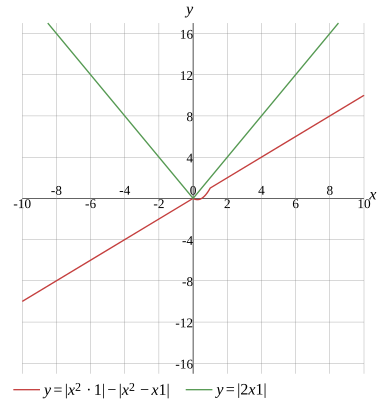Question
Solve the equation
x=0
Evaluate
x2×1−x2−x×1=∣2x×1∣
Simplify
More Steps


Evaluate
x2×1−x2−x×1
Any expression multiplied by 1 remains the same
x2×1−x2−x
Any expression multiplied by 1 remains the same
x2−x2−x
When the expression in absolute value bars is not negative, remove the bars
x2−x2−x
x2−x2−x=∣2x×1∣
Multiply the terms
x2−x2−x=∣2x∣
Swap the sides
∣2x∣=x2−x2−x
Move the expression to the left side
∣2x∣−(x2−x2−x)=0
If a negative sign or a subtraction symbol appears outside parentheses, remove the parentheses and change the sign of every term within the parentheses
∣2x∣−x2+x2−x=0
Separate the equation into 4 possible cases
2x−x2+x2−x=0,2x≥0,x2−x≥02x−x2−(x2−x)=0,2x≥0,x2−x<0−2x−x2+x2−x=0,2x<0,x2−x≥0−2x−x2−(x2−x)=0,2x<0,x2−x<0
Calculate the sum or difference
More Steps


Evaluate
2x−x2+x2−x=0
Calculate the sum or difference
More Steps


Evaluate
2x−x2+x2−x
Subtract the terms
x−x2+x2
The sum of two opposites equals 0
x+0
Remove 0
x
x=0
x=0,2x≥0,x2−x≥02x−x2−(x2−x)=0,2x≥0,x2−x<0−2x−x2+x2−x=0,2x<0,x2−x≥0−2x−x2−(x2−x)=0,2x<0,x2−x<0
Solve the inequality
x=0,x≥0,x2−x≥02x−x2−(x2−x)=0,2x≥0,x2−x<0−2x−x2+x2−x=0,2x<0,x2−x≥0−2x−x2−(x2−x)=0,2x<0,x2−x<0
Solve the inequality
More Steps


Evaluate
x2−x≥0
Add the same value to both sides
x2−x+41≥41
Evaluate
(x−21)2≥41
Take the 2-th root on both sides of the inequality
(x−21)2≥41
Calculate
x−21≥21
Separate the inequality into 2 possible cases
x−21≥21x−21≤−21
Calculate
More Steps


Evaluate
x−21≥21
Move the constant to the right side
x≥21+21
Add the numbers
x≥1
x≥1x−21≤−21
Cancel equal terms on both sides of the expression
x≥1x≤0
Find the union
x∈(−∞,0]∪[1,+∞)
x=0,x≥0,x∈(−∞,0]∪[1,+∞)2x−x2−(x2−x)=0,2x≥0,x2−x<0−2x−x2+x2−x=0,2x<0,x2−x≥0−2x−x2−(x2−x)=0,2x<0,x2−x<0
Solve the equation
More Steps


Evaluate
2x−x2−(x2−x)=0
Calculate
2x−x2−x2+x=0
Calculate the sum or difference
More Steps


Evaluate
2x−x2−x2+x
Add the terms
3x−x2−x2
Subtract the terms
3x−2x2
3x−2x2=0
Factor the expression
More Steps


Evaluate
3x−2x2
Rewrite the expression
x×3−x×2x
Factor out x from the expression
x(3−2x)
x(3−2x)=0
When the product of factors equals 0,at least one factor is 0
x=03−2x=0
Solve the equation for x
More Steps


Evaluate
3−2x=0
Move the constant to the right-hand side and change its sign
−2x=0−3
Removing 0 doesn't change the value,so remove it from the expression
−2x=−3
Change the signs on both sides of the equation
2x=3
Divide both sides
22x=23
Divide the numbers
x=23
x=0x=23
x=0,x≥0,x∈(−∞,0]∪[1,+∞)x=0x=23,2x≥0,x2−x<0−2x−x2+x2−x=0,2x<0,x2−x≥0−2x−x2−(x2−x)=0,2x<0,x2−x<0
Solve the inequality
x=0,x≥0,x∈(−∞,0]∪[1,+∞)x=0x=23,x≥0,x2−x<0−2x−x2+x2−x=0,2x<0,x2−x≥0−2x−x2−(x2−x)=0,2x<0,x2−x<0
Solve the inequality
More Steps


Evaluate
x2−x<0
Add the same value to both sides
x2−x+41<41
Evaluate
(x−21)2<41
Take the 2-th root on both sides of the inequality
(x−21)2<41
Calculate
x−21<21
Separate the inequality into 2 possible cases
{x−21<21x−21>−21
Calculate
More Steps


Evaluate
x−21<21
Move the constant to the right side
x<21+21
Add the numbers
x<1
{x<1x−21>−21
Cancel equal terms on both sides of the expression
{x<1x>0
Find the intersection
0<x<1
x=0,x≥0,x∈(−∞,0]∪[1,+∞)x=0x=23,x≥0,0<x<1−2x−x2+x2−x=0,2x<0,x2−x≥0−2x−x2−(x2−x)=0,2x<0,x2−x<0
Solve the equation
More Steps


Evaluate
−2x−x2+x2−x=0
Calculate the sum or difference
More Steps


Evaluate
−2x−x2+x2−x
Subtract the terms
−3x−x2+x2
The sum of two opposites equals 0
−3x+0
Remove 0
−3x
−3x=0
Change the signs on both sides of the equation
3x=0
Rewrite the expression
x=0
x=0,x≥0,x∈(−∞,0]∪[1,+∞)x=0x=23,x≥0,0<x<1x=0,2x<0,x2−x≥0−2x−x2−(x2−x)=0,2x<0,x2−x<0
Solve the inequality
x=0,x≥0,x∈(−∞,0]∪[1,+∞)x=0x=23,x≥0,0<x<1x=0,x<0,x2−x≥0−2x−x2−(x2−x)=0,2x<0,x2−x<0
Solve the inequality
More Steps


Evaluate
x2−x≥0
Add the same value to both sides
x2−x+41≥41
Evaluate
(x−21)2≥41
Take the 2-th root on both sides of the inequality
(x−21)2≥41
Calculate
x−21≥21
Separate the inequality into 2 possible cases
x−21≥21x−21≤−21
Calculate
More Steps


Evaluate
x−21≥21
Move the constant to the right side
x≥21+21
Add the numbers
x≥1
x≥1x−21≤−21
Cancel equal terms on both sides of the expression
x≥1x≤0
Find the union
x∈(−∞,0]∪[1,+∞)
x=0,x≥0,x∈(−∞,0]∪[1,+∞)x=0x=23,x≥0,0<x<1x=0,x<0,x∈(−∞,0]∪[1,+∞)−2x−x2−(x2−x)=0,2x<0,x2−x<0
Solve the equation
More Steps


Evaluate
−2x−x2−(x2−x)=0
Calculate
−2x−x2−x2+x=0
Calculate the sum or difference
More Steps


Evaluate
−2x−x2−x2+x
Add the terms
−x−x2−x2
Subtract the terms
−x−2x2
−x−2x2=0
Factor the expression
More Steps


Evaluate
−x−2x2
Rewrite the expression
−x−x×2x
Factor out −x from the expression
−x(1+2x)
−x(1+2x)=0
When the product of factors equals 0,at least one factor is 0
−x=01+2x=0
Solve the equation for x
x=01+2x=0
Solve the equation for x
More Steps


Evaluate
1+2x=0
Move the constant to the right-hand side and change its sign
2x=0−1
Removing 0 doesn't change the value,so remove it from the expression
2x=−1
Divide both sides
22x=2−1
Divide the numbers
x=2−1
Use b−a=−ba=−ba to rewrite the fraction
x=−21
x=0x=−21
x=0,x≥0,x∈(−∞,0]∪[1,+∞)x=0x=23,x≥0,0<x<1x=0,x<0,x∈(−∞,0]∪[1,+∞)x=0x=−21,2x<0,x2−x<0
Solve the inequality
x=0,x≥0,x∈(−∞,0]∪[1,+∞)x=0x=23,x≥0,0<x<1x=0,x<0,x∈(−∞,0]∪[1,+∞)x=0x=−21,x<0,x2−x<0
Solve the inequality
More Steps


Evaluate
x2−x<0
Add the same value to both sides
x2−x+41<41
Evaluate
(x−21)2<41
Take the 2-th root on both sides of the inequality
(x−21)2<41
Calculate
x−21<21
Separate the inequality into 2 possible cases
{x−21<21x−21>−21
Calculate
More Steps


Evaluate
x−21<21
Move the constant to the right side
x<21+21
Add the numbers
x<1
{x<1x−21>−21
Cancel equal terms on both sides of the expression
{x<1x>0
Find the intersection
0<x<1
x=0,x≥0,x∈(−∞,0]∪[1,+∞)x=0x=23,x≥0,0<x<1x=0,x<0,x∈(−∞,0]∪[1,+∞)x=0x=−21,x<0,0<x<1
Find the intersection
x=0x=0x=23,x≥0,0<x<1x=0,x<0,x∈(−∞,0]∪[1,+∞)x=0x=−21,x<0,0<x<1
Find the intersection
x=0x∈∅x=0,x<0,x∈(−∞,0]∪[1,+∞)x=0x=−21,x<0,0<x<1
Find the intersection
x=0x∈∅x∈∅x=0x=−21,x<0,0<x<1
Find the intersection
x=0x∈∅x∈∅x∈∅
Solution
x=0
Show Solution

Graph
